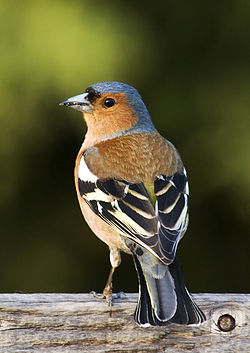Fringilla
| Fringilla | |
|---|---|
 |
|
| Male common chaffinch | |
| Scientific classification | |
| Kingdom: | Animalia |
| Phylum: | Chordata |
| Class: | Aves |
| Order: | Passeriformes |
| Suborder: | Passeri |
| Infraorder: | Passerida |
| Superfamily: | Passeroidea |
| Family: | Fringillidae |
| Subfamily: |
Fringillinae Leach, 1820 |
| Genus: |
Fringilla Linnaeus, 1758 |
| Species | |
The genus Fringilla is a small group of finches from the Old World, which are the only species in the subfamily Fringillinae. The genus name Fringilla is Latin for "finch".
The four species are:
The common chaffinch is found primarily in forest habitats, in Europe, North Africa, and western Asia; the blue chaffinch is an island endemic; and the brambling breeds in the northern taiga and southern tundra of Eurasia.
The three species are about the same size, 15 centimetres (5.9 in) in length, and are similar in shape. They have a bouncing flight with alternating bouts of flapping and gliding on closed wings. They are not as specialised as the other finches, eating both insects and seeds. While breeding, they feed their young on insects rather than seeds, unlike the other finches.
In 2016 it was proposed that the extremely rare Gran Canaria subspecies F. teydea polatzeki be treated as a separate species, thus creating a fourth species, F. polatzeki.
...
Wikipedia
